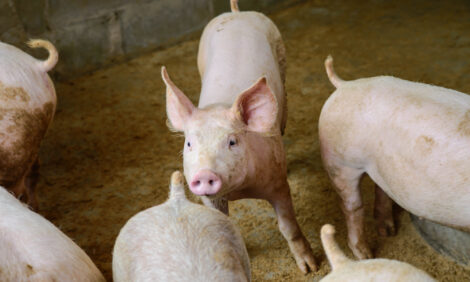



Weekly Roberts Report
US - Agricultural US Commodity Market Report by Mike Roberts, Commodity Marketing Agent, Virginia Tech.LEAN HOGS on the CME were higher on Monday with the exception of the nearby December. The DEC’09LH contract closed down $0.050/cwt at $54.950/cwt and $0.85/cwt lower than this time last week. FEB’10LH futures finished at $62.350/cwt; up $0.500/cwt but $0.975/cwt lower than last report. December futures suffered from late rolling of long positions into February and other deferreds. Outside markets and a weaker US dollar were supportive. USDA on Friday reported the average pork price at $57.380/cwt; up $0.26/cwt. The latest CME lean hog index was placed at $55.47/cwt; down $0.03/cwt but $0.15/cwt higher than this time last week. Packer demand is still decent. According to HedgersEdge.com, the average pork plant margin was lowered $1.20/head from last week to a positive $3.50/head. This was based on the average buy of $39.28/cwt vs. the average breakeven price of $40.59/cwt.
CORN futures on the Chicago Board of Trade (CBOT) finished up again on Monday. DEC’09 corn futures finished at $4.022/bu; up 11.75¢/bu and 16.25¢/bu higher than last Monday. The MAY’10 contract closed at $4.274; up 11.75¢/bu and 17.25¢/bu higher than last report. Outside markets, a weaker US dollar, wet weather, and the struggle to get harvest done amid wet weather were supportive factors. Gold and crude oil made significant gains. USDA late Monday put the US corn crop at 54 per cent harvested vs. the 5-year average of 89 per cent. Floor sources said the market expected 50-60 per cent. There is an additional concern with this year’s corn crop; Vomitoxin. Vomitoxin is fungus derived from wet, poor quality corn. Today the CME Group set new limits on the corn they will accept for delivery that is affected by the fungus. Even though the US dollar makes them attractive, exports were bearish as foreign traders waited to see if harvest will pick back up. With corn supplies this good there really is no fundamental reason that corn should be trading this high. USDA placed corn-inspected-for-export at 21.937 mi bu vs. expectations for 27-33 mi bu and 5.89 mi bu lower than last week. Cash corn in the US Midwest was steady to firm while corn bids in the US Mid-Atlantic states was firm ranging 2.0¢/bu - 8.0¢/bu higher. Funds started shedding net-bear positions as they get in the buying mood. Gold and crude oil are soaring providing plenty of money to hedge funds who then need to balance the books against these huge profits. Funds bought 15,000 – 16,000 contracts. It is a good idea to consider selling the rest of the ’09 corn crop and as much as 30 per cent of the 2010 crop on these market upticks.
SOYBEAN futures on the Chicago Board of Trade (CBOT) finished strong on Monday. NOV’09 soybean futures’ last day to trade was November 13. JAN’10 soybean futures closed at $10.100/bu; up 23.0¢/bu. The MAR’10 soybean contract closed at $10.156/bu; up 23.5¢/bu and 37.75¢/bu cents over last report. A weaker dollar, firm outside markets, forecasts for bad harvest weather, and speculative buying were supportive. CME Group concerns over corn Vomitoxin are seen as supportive as feeders shift protein sources from corn to soybeans. USA placed soybeans-inspected-for-exports at 59.845 mi bu vs. expectations for 50 – 60 mi bu. This was 4.192 mi bu lower than last week. USDA late Monday placed soybean harvest at 89 per cent complete. The 5-year average is 96 per cent. Even though funds bought 3,000 contracts net-bull positions declined for the week ended Tuesday. If you haven’t done so already it would be a good idea to get the rest of the 2009 crop sold and consider selling 20 per cent of the ’10 crop at this time.
WHEAT futures in Chicago (CBOT) finished up Monday strictly on technical buying by large funds and speculators. DEC’09 futures closed at $5.622/bu; up 23.25¢/bu and 42.25¢/bu higher than a week ago. The JULY’10 wheat contract closed at $6.072/bu; up 23.75¢/bu and 42.0¢/bu higher than last report. The jump in wheat prices represents a 4 per cent increase. It comes on the same strengths that fueled the corn and soybean rallies. According to one source, “Hedge funds are buying because they are flush with money from outside markets and they have to balance their books going into the holiday. That means buy, buy, and buy! In addition to that, they are borrowing money like mad on zero percent interest to speculate with. Look out.” Late in the day a statement by US Federal Reserve Chairman Ben Bernanke indicated he was concerned about the declining value of the dollar and was monitoring the situation closely as part of its commitment to both jobs growth and price stability (?). Funds bought an estimated 4,000 contracts while large speculators held huge net-bear positions. This should stimulate short covering in the coming days as there is absolutely no fundamental reason for these prices. USDA reported wheat-inspected-for-export at 15.047 mi bu vs. expectations for 14 – 18 mi bu. Exports were placed at 17.778 mi bu last week. It would be an extremely good idea to price up to 20 - 30 per cent of the 2010 wheat crop now.









